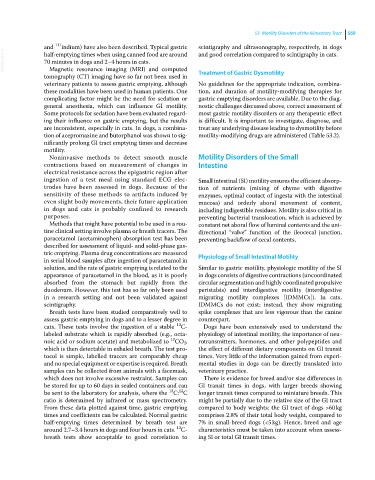Page 601 - Clinical Small Animal Internal Medicine
P. 601
53 Motility Disorders of the Alimentary Tract 569
and 111 indium) have also been described. Typical gastric scintigraphy and ultrasonography, respectively, in dogs
VetBooks.ir half‐emptying times when using canned food are around and good correlation compared to scintigraphy in cats.
70 minutes in dogs and 2–4 hours in cats.
Magnetic resonance imaging (MRI) and computed
tomography (CT) imaging have so far not been used in Treatment of Gastric Dysmotility
veterinary patients to assess gastric emptying, although No guidelines for the appropriate indication, combina-
these modalities have been used in human patients. One tion, and duration of motility‐modifying therapies for
complicating factor might be the need for sedation or gastric emptying disorders are available. Due to the diag-
general anesthesia, which can influence GI motility. nostic challenges discussed above, correct assessment of
Some protocols for sedation have been evaluated regard- most gastric motility disorders or any therapeutic effect
ing their influence on gastric emptying, but the results is difficult. It is important to investigate, diagnose, and
are inconsistent, especially in cats. In dogs, a combina- treat any underlying disease leading to dysmotility before
tion of acepromazine and butorphanol was shown to sig- motility‐modifying drugs are administered (Table 53.2).
nificantly prolong GI tract emptying times and decrease
motility.
Noninvasive methods to detect smooth muscle Motility Disorders of the Small
contractions based on measurement of changes in Intestine
electrical resistance across the epigastric region after
ingestion of a test meal using standard ECG elec- Small intestinal (SI) motility ensures the efficient absorp-
trodes have been assessed in dogs. Because of the tion of nutrients (mixing of chyme with digestive
sensitivity of these methods to artifacts induced by enzymes, optimal contact of ingesta with the intestinal
even slight body movements, their future application mucosa) and orderly aboral movement of content,
in dogs and cats is probably confined to research including indigestible residues. Motility is also critical in
purposes. preventing bacterial translocation, which is achieved by
Methods that might have potential to be used in a rou- constant net aboral flow of luminal contents and the uni-
tine clinical setting involve plasma or breath tracers. The directional “valve” function of the ileocecal junction,
paracetamol (acetaminophen) absorption test has been preventing backflow of cecal contents.
described for assessment of liquid‐ and solid‐phase gas-
tric emptying. Plasma drug concentrations are measured Physiology of Small Intestinal Motility
in serial blood samples after ingestion of paracetamol in
solution, and the rate of gastric emptying is related to the Similar to gastric motility, physiologic motility of the SI
appearance of paracetamol in the blood, as it is poorly in dogs consists of digestive contractions (uncoordinated
absorbed from the stomach but rapidly from the circular segmentation and highly coordinated propulsive
duodenum. However, this test has so far only been used peristalsis) and interdigestive motility (interdigestive
in a research setting and not been validated against migrating motility complexes [IDMMCs]). In cats,
scintigraphy. IDMMCs do not exist; instead, they show migrating
Breath tests have been studied comparatively well to spike complexes that are less vigorous than the canine
assess gastric emptying in dogs and to a lesser degree in counterpart.
13
cats. These tests involve the ingestion of a stable C‐ Dogs have been extensively used to understand the
labeled substrate which is rapidly absorbed (e.g., octa- physiology of intestinal motility, the importance of neu-
13
noic acid or sodium acetate) and metabolized to CO 2 , rotransmitters, hormones, and other polypeptides and
which is then detectable in exhaled breath. The test pro- the effect of different dietary components on GI transit
tocol is simple, labelled tracers are comparably cheap times. Very little of the information gained from experi-
and no special equipment or expertise is required. Breath mental studies in dogs can be directly translated into
samples can be collected from animals with a facemask, veterinary practice.
which does not involve excessive restraint. Samples can There is evidence for breed and/or size differences in
be stored for up to 60 days in sealed containers and can GI transit times in dogs, with larger breeds showing
13
12
be sent to the laboratory for analysis, where the C: C longer transit times compared to miniature breeds. This
ratio is determined by infrared or mass spectrometry. might be partially due to the relative size of the GI tract
From these data plotted against time, gastric emptying compared to body weights: the GI tract of dogs >60 kg
times and coefficients can be calculated. Normal gastric comprises 2.8% of their total body weight, compared to
half‐emptying times determined by breath test are 7% in small‐breed dogs (<5 kg). Hence, breed and age
13
around 2.7–3.4 hours in dogs and four hours in cats. C‐ characteristics must be taken into account when assess-
breath tests show acceptable to good correlation to ing SI or total GI transit times.

